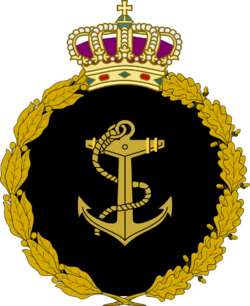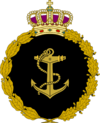Royal Holyn Navy
| Royal Holyn Navy | |
|---|---|
 Emblem of the Royal Holyn Navy | |
| Founded | 17 February 1891 |
| Country | |
| Type | Navy |
| Role | Naval warfare |
| Size |
|
| Part of | |
| Fleet |
|
| Engagements |
|
| Commanders | |
| Commander | Admiral Viktor Volf |
| Ceremonial chief | Admiral |
| Insignia | |
| Flag and ensign |  |
| Jack |  |
| Badge |  |
The Royal Holyn Navy is the naval warfare branch of the Royal Holyn Defence Forces. It has existed in a number of forms since the 16th century. The current iteration was formed in 1999, when it inherited the navy of the Holyn Socialist Union. It is the second largest branch of the Holyn military.
Holynia maintained a large surface fleet of armed merchant ships from the 1500s to late 1600s. In 1661, the first formal Holyn Navy was formed becoming the official naval fighting branch of the King. During the Holyn Civil War, much of the navy had joined the communist rebellion. During the communist era, the Navy received increased investment. It transformed from a green water navy in the 1940s to a true blue water navy by the 1970s. The Navy reached its largest size in 1990, with 501 combat ships.
Following the fall of communism, the Navy had its budget significantly reduced. Procurement all but stopped by 1999. The early 2000s saw limited procurement of new ships. Military reforms in 2005 saw heavy emphasis placed on maintaining a powerful navy. The renewed focus on the Navy saw major restructuring of the Navy around designing new destroyers, cruisers and amphibious assault ships.
History
The Holyn Navy traces much of its history to to the battle force assembled by Alex I during the Catastrophe in the 12th century. A decisive naval battle between sailing ships of the Grolan Empire and the Holyn Realm cemented Holynia as a naval power. Following the reconstruction period in the 12th and 13th centuries, Holynia's various trading enterprises were tasked with exploration and colononization of the northern Sayuin coast. The ships of the King, as they officially were called, were ships under direct command of the King and the de-facto Navy of Holynia during this period. Navy ships were not tasked with exploration or colonising duties, but did escort private vessels through the busy Great Spero Sea.
The Navy was again sidelined during the initial periods of Holyn colonising in Navron during the 16th century, with the King opting to utilize private trading companies to conquer these lands. However, the colony of Skoskie became a major naval hub in the 17th century, allowing the monarchy close oversight of the privateer Holyn fleets operating here.
In the 19th century, the Navy participated in its first major battle since the Catastrophy, again with the Grolan Empire. This saw the worlds first usage of steam ships in battle. A series of defeats saw the Holyn Navy decisive defeats in the Northern Spero Sea saw Holynia's navy sidelined to coastal defence. However, the Royal Holyn Navy was instrumental in the Battle of Relo, where Holyn ships shelled the city. During this century, the Royal Holyn Navy inherited more duties of exploration. Private individuals and companies became more restricted in their ability to use force, so Navy ships were required to escort research companies. As industrialisation expanded in Holynia, the shipbuilding abilities of the country improved. Holynia operated the 3rd largest navy in Spero by 1900.
This became instrumental as Holynia possesed the largest Navy of the Eastern Powers during the Great Spero War in 1917. The Holyn Navy was credited with forcing the stalemate which ended the war, following a series of decisive battles in western Spero. The Holyn Navy, however, sufferred in the political chaos of the early 20th century.
The Royal Navy remained loyal to the monarchy, providing safe haven and transport during the Great Escape of 1927. The Royal Navy fled mainland Holynia, with the Royal Family, to the overseas colony of Skoskie. The Royal Navy provided the basis of the Navy of newly independent Skoskie during the 1930s.
The Communists found themselves with outdated ships left behind during the Great Escape. The modern, capable ships had fled the ports prior to their capture by the Communists. Only outdated, small ships were abandoned.
The government of the newly founded Union of Holyn Socialist States founded the Fleet of the Workers. As the effort to rebuild the nation progressed, the new military command put emphasis on the ground army. By 1935, the military began to plan a build up of the Navy. Neighboring powers in Spero were putting major emphasis on building powerful Navies and Air Forces, while Holynia had a small coastal force and limited aerial forces. Shipbuilding capabilities began to be ramped up in the 1930s. Holyn shipyards, by 1933, were capable of building 10,000 tonne civilian ships, but were given the task of building roughly 60,000 tonne battleships.
This fleet of battleships came at a time of growing competitition between the naval powers of Spero. The death of Volen Hajek saw a major reorganization of the military. New leader Jan Kříž put a heavy emphasis on overseas expansion of communism and saw the Navy as a critical asset. The Navy was reorganized into the Western Fleet, Central Fleet, and the Eastern Fleet. Its headquarters was established in Slatnik.
By 1945, the Navy had a fleet of 10 battleships, 4 Rolník class and 6 Chránit class battleships. These were the new flagships of the Navy. In 1947, Holynia launched its first overseas endeavor into Navron. Salcheny, a colony of Pamtoria, was fighting a war of independence. The Holyn Navy deployed several warships and transport ships to support the communist faction, the Salcheny People's Liberation Army. The withdrawal of Pamtoria was seen largely as the consequence of the Holyn deployment. The SPLA rapidly increased its capabilities after arms shipments from Holynia.
The Navy numbered roughly 300 ships by 1950. Construction efforts focused on cruisers, submarines and small missile boats. Throughout the 1960s, the Navy began to place significant emphasis on fleet defence capabilities, primarily through mid-sized aircraft carriers and small missile boats. Ships of all sizes had their decks packed with long range missiles. Submarine technology was also significantly improved on during the 1960s.
In 1973, the first Utena class aircraft carrier was commissioned. The 1970s and 1980s would see immense improvements of the capabilities of the Navy. The nuclear powered Pozorká class heavy battlecruisers were introduced in the 1980s, alongside Project 166 and Project 170 destroyers.
The diversification of various ship classes would come to an end in the 1990s. Commander of the Navy, Admiral Jaroslav Kopecký, sought to simplify the fleet. The growing budget issues of the government helped this endeavour. Procurement emphasised universal platforms, contrasting with ships built for a single purpose.
Ship procurement steadily declined in the 1990s, all but coming to a halt by 1998. In 2001, the Holyn Navy inherited the fleet of the Skoskie Navy. Formally, the Skoskie Navy inherited the mainland Navy, to allow continuity with the pre-revolutionary Navy. The post reunification Navy sought to continue the efforts that it had begun in the 1990s. New classes of warships would be able to take on multiple roles. Changes in training and rankform were completed in 2005. Other reforms saw the Naval Infantry become the Royal Holyn Marines in 2003.
Organization
Command and control of the Royal Holyn Navy is divided into several organizations within the Navy. The combat and support forces are divided into three fleets, with their own headquarters and chain of command. Each fleet reports to the operational command of the Royal Holyn Defence Forces.
Fleets
- 1st Fleet is based in Maslovce, Holynia in south east Holynia.
- 2nd Fleet is based in Nemečky, Holynia in western Holynia.
- 3rd Fleet is based in Slatnik, Holynia in southern Holynia.